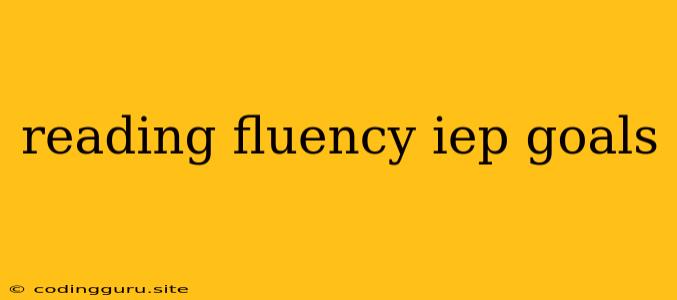Unlocking the Potential: Crafting Effective Reading Fluency IEP Goals
Creating a successful Individualized Education Program (IEP) for students with reading difficulties requires a deep understanding of their specific needs. Reading fluency is a crucial aspect of reading comprehension and overall academic success. But how can you effectively translate a student's needs into measurable and achievable reading fluency IEP goals? This article aims to guide you through the process of crafting impactful reading fluency IEP goals that empower students to reach their full reading potential.
Understanding the Importance of Reading Fluency
Reading fluency is more than just reading words quickly; it encompasses three key elements:
- Rate: The speed at which a student can read words accurately.
- Accuracy: The ability to pronounce words correctly with minimal errors.
- Prosody: Reading with expression, phrasing, and intonation that conveys meaning and engages the listener.
Students struggling with reading fluency often face challenges in:
- Comprehending what they read: Without the ability to read smoothly and accurately, students may struggle to process the meaning of the text.
- Developing a positive reading experience: Struggling with reading fluency can lead to frustration and a negative attitude towards reading.
- Keeping up with their peers academically: Difficulties with reading fluency can impede progress in all subject areas.
Crafting Effective Reading Fluency IEP Goals
When crafting reading fluency IEP goals, consider these key principles:
1. Be Specific and Measurable:
- Avoid vague goals like "improve reading fluency." Instead, use specific benchmarks like "increase words per minute (WPM) by 10" or "reduce error rate by 5%."
- Set measurable objectives that can be tracked and evaluated.
2. Target Individual Needs:
- Assess the student's current reading fluency level using standardized assessments or informal measures.
- Identify the specific areas where the student needs improvement, whether it be rate, accuracy, or prosody.
- Tailor goals to the student's individual learning style and strengths.
3. Be Achievable and Realistic:
- Set goals that are challenging but achievable within the designated timeframe.
- Break down large goals into smaller, manageable steps to ensure success.
- Provide opportunities for regular progress monitoring to adjust goals as needed.
4. Align with the Student's Curriculum:
- Integrate reading fluency goals with the student's current curriculum and grade level expectations.
- Ensure that the texts used for practice and assessment are appropriate for the student's reading level.
5. Emphasize Progress and Growth:
- Focus on celebrating the student's progress, no matter how small.
- Encourage a growth mindset and emphasize the value of effort and perseverance.
Examples of Reading Fluency IEP Goals
Here are some examples of reading fluency IEP goals tailored to different student needs:
- Goal: Increase words per minute (WPM) from 50 to 70 on grade-level passages.
- Goal: Reduce error rate on reading passages from 10% to 5%.
- Goal: Demonstrate appropriate phrasing and intonation when reading aloud.
- Goal: Improve fluency on reading passages that include specific target vocabulary words.
- Goal: Develop effective strategies for self-monitoring and correcting reading errors.
Strategies to Enhance Reading Fluency
Once you've established reading fluency IEP goals, you need to implement strategies to help students achieve them. Here are some proven approaches:
- Repeated Reading: Have students repeatedly read the same text multiple times. This helps improve automaticity and reduce errors.
- Choral Reading: Students read aloud together in unison. This promotes rhythm and timing, enhancing fluency.
- Partner Reading: Students read aloud to each other, taking turns. This provides feedback and encourages active listening.
- Reader's Theatre: Students perform short plays or scripts, focusing on expression and intonation.
- Technology-Based Tools: Utilize software programs or apps designed to improve reading fluency, such as fluency builders and reading games.
- Focus on Prosody: Guide students on using their voice to convey meaning through pitch, volume, and pacing.
- Provide Explicit Instruction: Teach students strategies for decoding unfamiliar words, recognizing sight words, and using context clues.
Ongoing Assessment and Monitoring
Regularly assess the student's progress towards their reading fluency IEP goals. This can be done through:
- Formal Assessments: Use standardized tests designed to measure reading fluency.
- Informal Measures: Observe the student's reading performance in different contexts, such as during reading group or independent reading.
- Running Records: Record the student's reading performance as they read a passage aloud, noting errors and strategies used.
- Teacher Observations: Note any changes in the student's reading fluency, accuracy, and prosody over time.
Collaboration and Communication
Effective reading fluency IEP goals require ongoing collaboration between the teacher, student, and parents. Ensure open communication about:
- Progress towards goals: Regularly share updates and feedback on the student's progress.
- Challenges encountered: Identify any obstacles or difficulties the student is facing.
- Strategies implemented: Explain the approaches used to improve reading fluency.
- Home support: Encourage parents to support their child's reading fluency development at home through activities like reading aloud together or playing reading games.
Conclusion
Developing effective reading fluency IEP goals is crucial for helping students with reading difficulties achieve academic success. By understanding the importance of reading fluency, crafting specific and measurable goals, implementing proven strategies, and fostering collaboration, you can empower students to unlock their full reading potential and build a strong foundation for lifelong learning. Remember to celebrate progress, encourage a growth mindset, and make the journey towards reading fluency a positive and rewarding experience for all involved.
